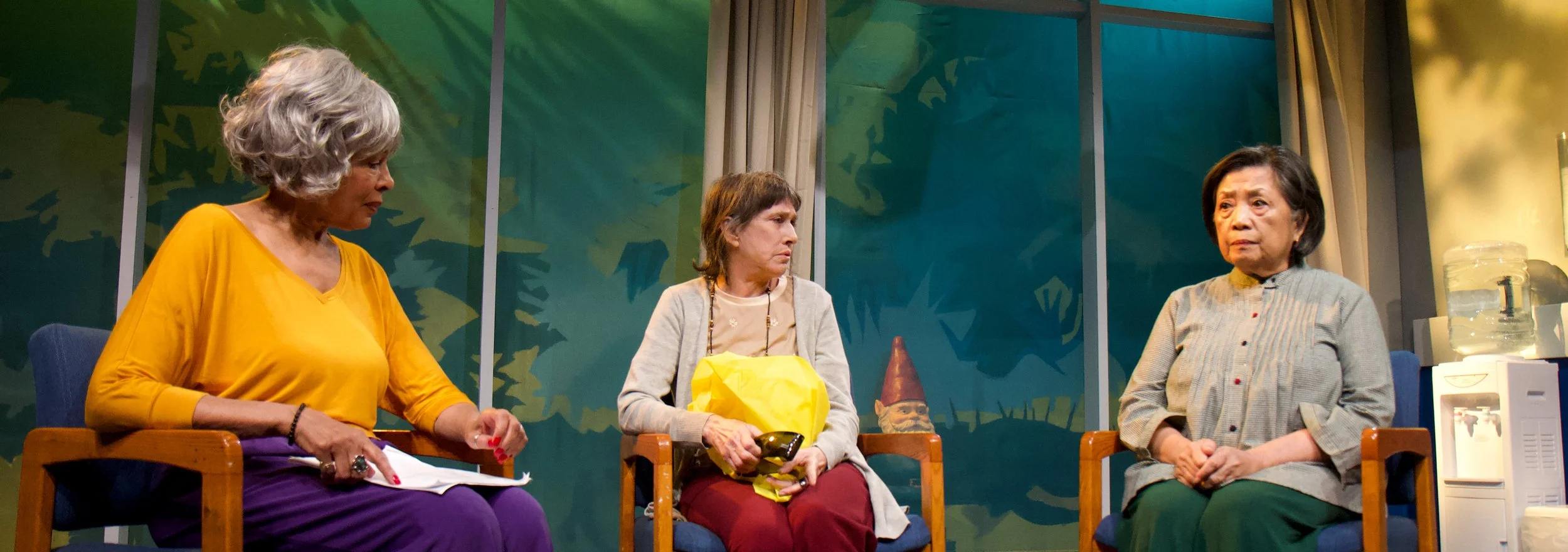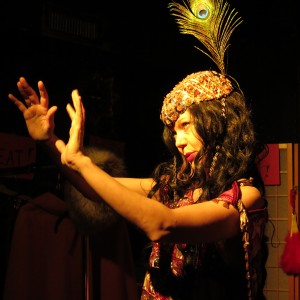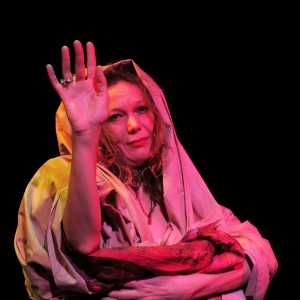The small stage where Almost Mata Hari: Lovers, Letters and Killers by Eva Dorrepaal which explores the life of Mata Hari, the infamous courtesan-cum-spy, as well as parallels to the dangerous loves in her own life, is tucked away in the basement of Theater for the New City. This venue has many theaters; two are in the basement on opposite sides of the building. But the spectator is rewarded with the discovery of finding the right door. And descending the dark staircase is the perfect entrée to Dorrepaal’s world. Set as a living room, it looks as if it will explode with one false move: clothing and bric-a-brac are strewn everywhere. Short directives such as “Breathe” are pasted everywhere, as are Dorrepaal’s notes about Mata Hari: a timeline of her life and lists of men. The feeling is potentially claustrophobic and one wonders if Dorrepaal has been reading up on the avant-garde theater provocateur, Antonin Artaud’s concept of a “Theatre of Cruelty” which called for the "communion between actor and audience in a magic exorcism (…) to shock the spectator into seeing the baseness of his world.” Artaud was known to stage plays or scenes in isolated places where, one person who attended an Artaud play in the '60s, claims, “there could have been a murder and no one would have known.”
Dorrepaal appears debased at first—her clothing is disheveled, and she is harried and seemingly uncomfortable. She recalls an early abusive relationship: a broken jaw leads her to a dentist whom she eventually takes up a relationship with. Dorrepaal’s play begins in an emotionally Artaudian vein: two hours of listening to stories about violent relationships would have definitely felt entrapping and scary. She briskly changes pace and shifts the focus.
As an actress, Dorrepaal is fidgety, breathless and wide-eyed, which gives the impression of a woman on the verge of a nervous breakdown. However, there are interesting angles being worked which reveal three distinct layers: how an actress prepares (Dorrepaal refers to the method acting approach of using sense memory), her personal stories about past lovers, and her response as both an actress and woman to the story of Mata Hari’s life. The premise of Dorrepaal’s show is that she is an actress writing a play about Mata Hari. However, Dorrepaal inserts herself into the performance, and comments on the difficulty of acting, as well as the role of Mata Hari. Under the guide of a less gifted actress, this triadic approach could have been confusing, but Dorrepaal is a masterful performer. And funny too. In one scene, Dorrepaal is playing Mata Hari as a dancer and courtesan. She changes in front of us and puts on an Indian dance costume, with a spangly bra and a full skirt. As Mata Hari she’s dancing, but after awhile Dorrepaal, the woman, gets fed up and screams: “She’s so crazy” (about Mata Hari) and “Fuck, I’m going to have to hire a choreographer” (about herself as a performer). There are many more moments like this that lift the show from a purgatory exploration of women’s abusive relationships to a true exploration of the complexity of being a woman, of love and of being an actress.
Dorrepaal brings to light the dangerous nature of love. Mata Hari had many lovers—particularly military men in high commanding positions—and was rewarded richly with money and goods. She was known to be a spy but no one knew whether she did it for the money or because she could. In the end, she was convicted to death by a firing squad for being a spy; supposedly betrayed by one of her lovers. Dorrepaal informs us that “she died like a man” because she refused a blindfold. Dorrepaal also experienced dangerous love, first with the man in her early years who broke her jaw, and then with Dragan Zabek, an “irresistible mystic who worked as a street performer.” Dorrepaal leaves Holland, her native land, when she wins a green card only to learn that Dragan killed his former girlfriend—viciously strangling her and dragging her from one place to another—and then hung himself in prison.
Dorrepaal is an intriguing actress. She is tall and thin and looks like she has lived life. Her natural hair, which is a wiry reddish brown, often behaves like the wig she dons when she portrays Mata Hari. When she flips it over to one side, it stays there. Other times, it flairs around her face, making her look angry or seductive depending on the angle. Dorrepaal is a shape-shifter as a performer.
In another actor, this could prove frustrating or make her seem uncommitted to her role, but in Dorrepaal, we see a range of emotion pass across her face in a small time span. Sometimes she looks beautiful, other times tormented. This shape-shifting of emotion seems more true to life in the face of dangerous love, which heightens the senses so that desire, fear and uncertainty exist simultaneously.
Almost Mata Hari: Lovers, Letters and Killers, written and performed by Eva Dorrepaal, runs until Jan. 24 at Theater for the New City (155 First Ave. between East 9th and 10th Sts.). Performances are Thursday-Saturday at 8 p.m. and Sunday at 3 p.m. Tickets are $10 and can be purchased by calling the box office at 212-254-1109 or visiting www.theaterforthenewcity.net.








